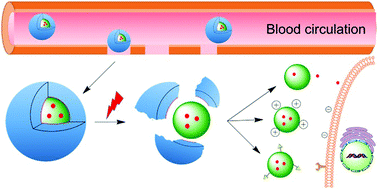Chen et al. discuss the emerging antitumor applications of extracellularly reengineered polymeric nanocarriers.
Chen et al. write an informative and interesting review on the methods by which nanoparticle drug delivery vehicles are engineered using diverse triggers that result in drug release.
In the field of drug delivery, particularly to sites of tumour, there are many different considerations – the drug must be delivered to the site of the tumour, it must be intact when delivered, and it must act to destroy cancerous tissue while remaining as nontoxic as possible to healthy tissue. As a result, much research has been devoted to the development of core-shell drug delivery structures that consist of the drug in the nanoparticle core surrounded by a protective shell. This protective shell may be removed using both internal and external triggers. Many nanocarriers use PEG (polyethylene glycol)-based shells for ease of solubility and in order to prevent proteins from being absorbed onto the surface of the shell. However, additional materials are also increasingly used for the development of these materials.
The authors review the materials as well as common strategies used to remove the shell. Specifically, they summarise literature that exploits changes in pH, since the acidity of the tumour microenvironment differs from its healthy surroundings. Charge-reversal nanocarriers with a positively charged core and a negatively charged shell are also used. In addition, enzymes can degrade the external shell. An enzyme family known as matrix metalloproteinases, or MMPs, is commonly used for this purpose, but other enzymes are also beginning to be explored. Finally, these nanocarriers can also be assembled or de-assembled using interactions between the nanocarrier and the host body.
Emerging antitumor applications of extracellularly reengineered polymeric nanocarriers by Jinjin Chen, Jianxun Ding, Chunsheng Xiao, Xiuli Zhuang and Xuesi Chen
Debanti Sengupta completed her PhD in Chemistry in 2012 from Stanford University. She was previously a Siebel postdoctoral scholar at the University of California, Berkeley, and is currently a postdoctoral scholar in Radiation Oncology at Stanford University. Follow her on Twitter @debantisengupta.
Follow the latest journal news on Twitter @BioMaterSci or go to our Facebook page.












